Case Study: Analyzing Make or Buy Decisions in Management Accounting
VerifiedAdded on 2023/05/28
|6
|1141
|105
Case Study
AI Summary
This case study analyzes a make or buy decision faced by a firm considering whether to manufacture a sub-assembly component in-house or purchase it from an external supplier. The assignment presents cost estimates for in-house production, including direct materials, direct labor, variable factory overhead, and fixed factory overhead. The supplier offers to provide the sub-assembly at a set price. The analysis involves calculating the relevant costs, considering which fixed overhead costs are avoidable if the component is purchased externally. The solution determines the per-unit cost for both options, considering the relevant costs, and recommends whether the firm should continue to make the component or buy it, ultimately concluding that the firm should continue making the sub-assembly component in-house due to cost savings. The case study emphasizes the importance of understanding relevant costs in making strategic decisions and provides a detailed breakdown of the cost analysis, including references to support the approach.
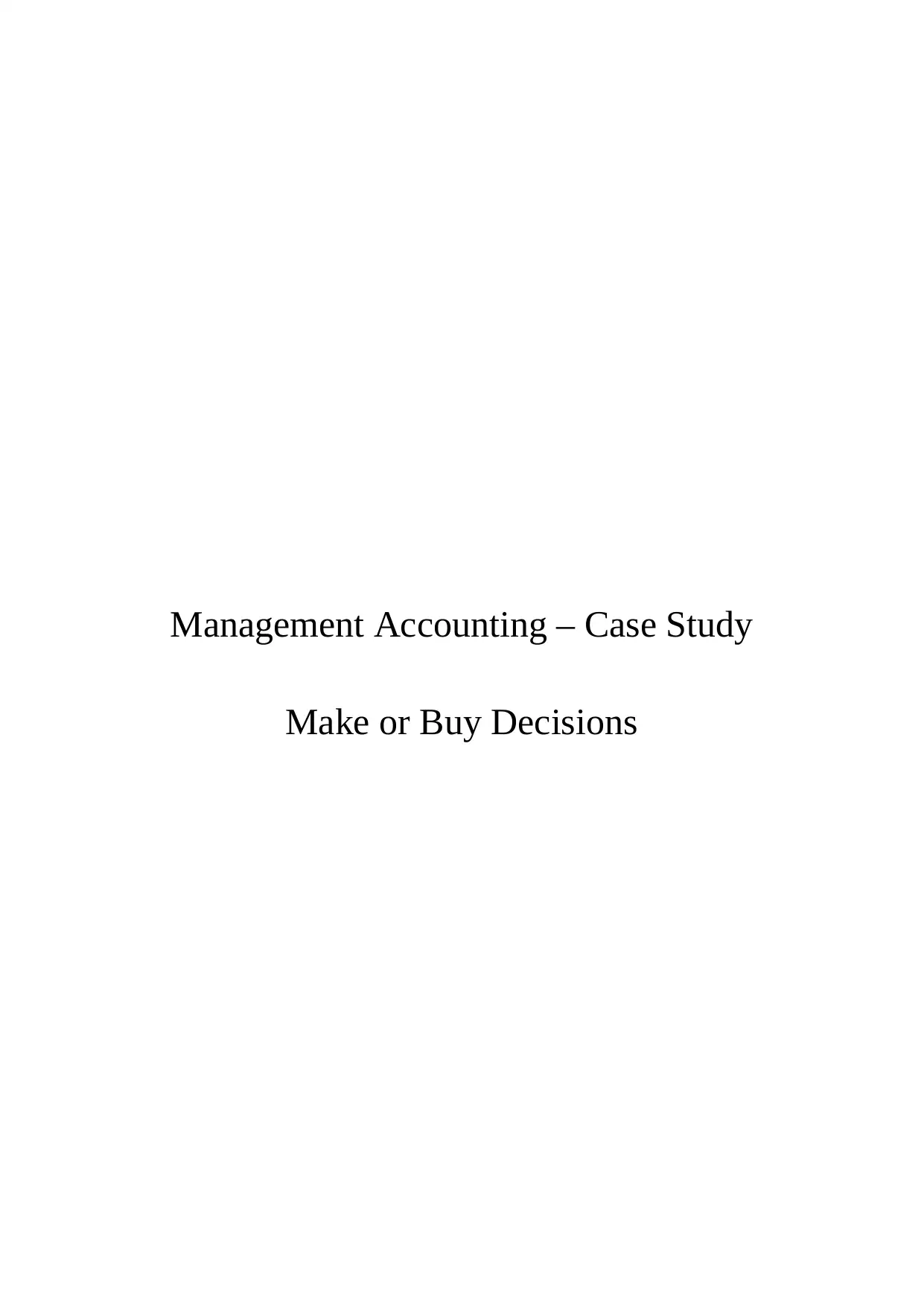
Management Accounting – Case Study
Make or Buy Decisions
Make or Buy Decisions
Paraphrase This Document
Need a fresh take? Get an instant paraphrase of this document with our AI Paraphraser
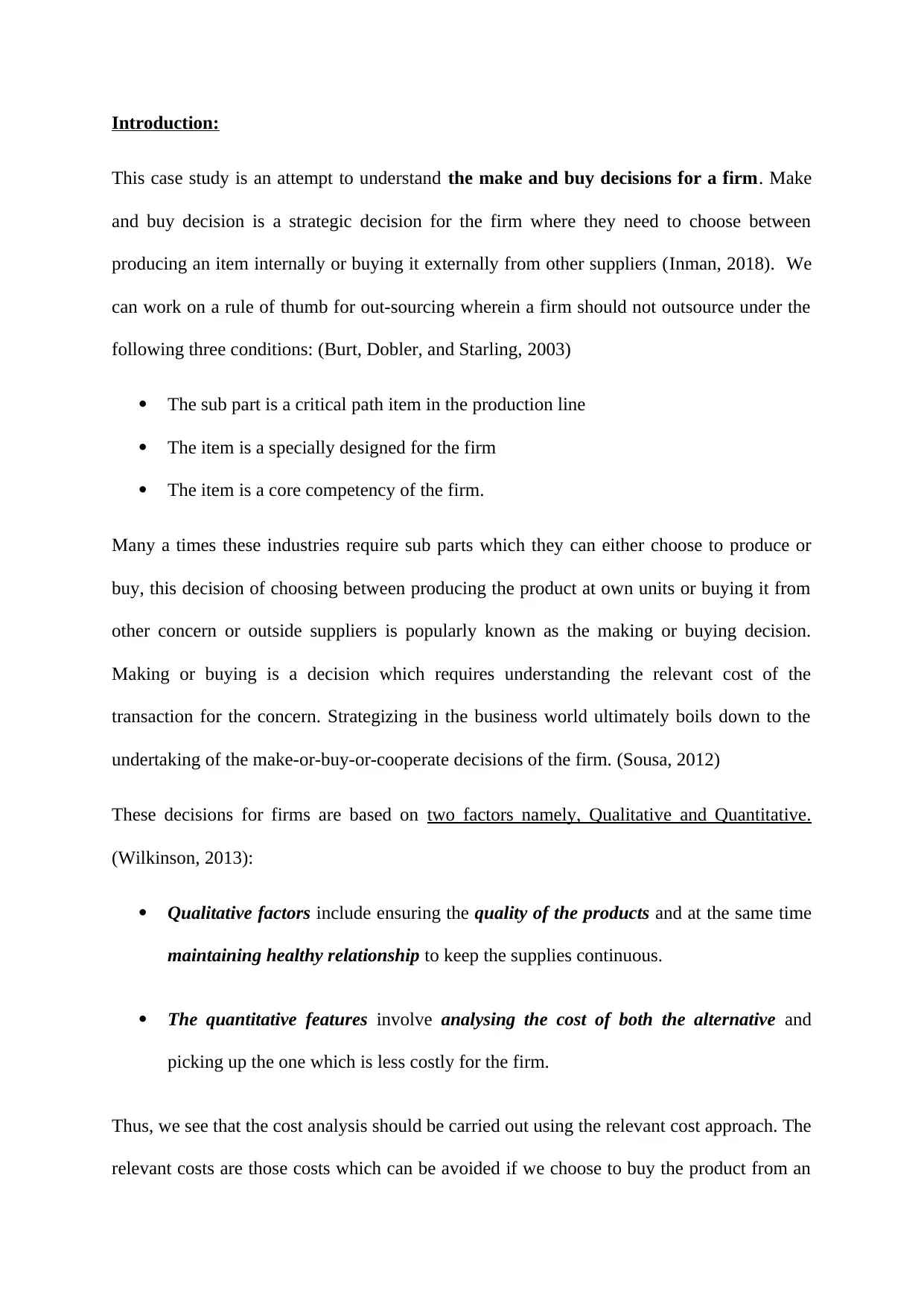
Introduction:
This case study is an attempt to understand the make and buy decisions for a firm. Make
and buy decision is a strategic decision for the firm where they need to choose between
producing an item internally or buying it externally from other suppliers (Inman, 2018). We
can work on a rule of thumb for out-sourcing wherein a firm should not outsource under the
following three conditions: (Burt, Dobler, and Starling, 2003)
The sub part is a critical path item in the production line
The item is a specially designed for the firm
The item is a core competency of the firm.
Many a times these industries require sub parts which they can either choose to produce or
buy, this decision of choosing between producing the product at own units or buying it from
other concern or outside suppliers is popularly known as the making or buying decision.
Making or buying is a decision which requires understanding the relevant cost of the
transaction for the concern. Strategizing in the business world ultimately boils down to the
undertaking of the make-or-buy-or-cooperate decisions of the firm. (Sousa, 2012)
These decisions for firms are based on two factors namely, Qualitative and Quantitative.
(Wilkinson, 2013):
Qualitative factors include ensuring the quality of the products and at the same time
maintaining healthy relationship to keep the supplies continuous.
The quantitative features involve analysing the cost of both the alternative and
picking up the one which is less costly for the firm.
Thus, we see that the cost analysis should be carried out using the relevant cost approach. The
relevant costs are those costs which can be avoided if we choose to buy the product from an
This case study is an attempt to understand the make and buy decisions for a firm. Make
and buy decision is a strategic decision for the firm where they need to choose between
producing an item internally or buying it externally from other suppliers (Inman, 2018). We
can work on a rule of thumb for out-sourcing wherein a firm should not outsource under the
following three conditions: (Burt, Dobler, and Starling, 2003)
The sub part is a critical path item in the production line
The item is a specially designed for the firm
The item is a core competency of the firm.
Many a times these industries require sub parts which they can either choose to produce or
buy, this decision of choosing between producing the product at own units or buying it from
other concern or outside suppliers is popularly known as the making or buying decision.
Making or buying is a decision which requires understanding the relevant cost of the
transaction for the concern. Strategizing in the business world ultimately boils down to the
undertaking of the make-or-buy-or-cooperate decisions of the firm. (Sousa, 2012)
These decisions for firms are based on two factors namely, Qualitative and Quantitative.
(Wilkinson, 2013):
Qualitative factors include ensuring the quality of the products and at the same time
maintaining healthy relationship to keep the supplies continuous.
The quantitative features involve analysing the cost of both the alternative and
picking up the one which is less costly for the firm.
Thus, we see that the cost analysis should be carried out using the relevant cost approach. The
relevant costs are those costs which can be avoided if we choose to buy the product from an
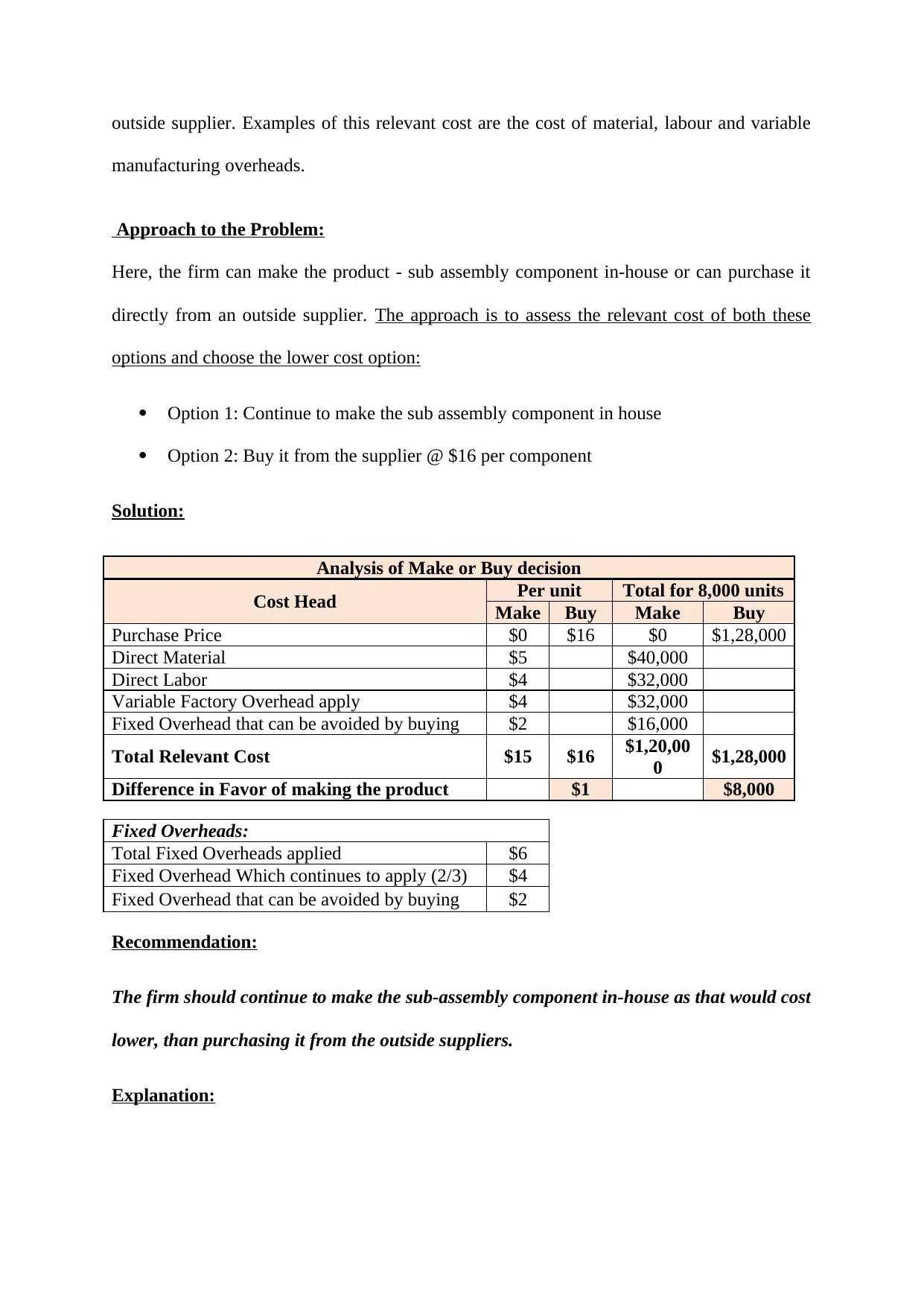
outside supplier. Examples of this relevant cost are the cost of material, labour and variable
manufacturing overheads.
Approach to the Problem:
Here, the firm can make the product - sub assembly component in-house or can purchase it
directly from an outside supplier. The approach is to assess the relevant cost of both these
options and choose the lower cost option:
Option 1: Continue to make the sub assembly component in house
Option 2: Buy it from the supplier @ $16 per component
Solution:
Analysis of Make or Buy decision
Cost Head Per unit Total for 8,000 units
Make Buy Make Buy
Purchase Price $0 $16 $0 $1,28,000
Direct Material $5 $40,000
Direct Labor $4 $32,000
Variable Factory Overhead apply $4 $32,000
Fixed Overhead that can be avoided by buying $2 $16,000
Total Relevant Cost $15 $16 $1,20,00
0 $1,28,000
Difference in Favor of making the product $1 $8,000
Fixed Overheads:
Total Fixed Overheads applied $6
Fixed Overhead Which continues to apply (2/3) $4
Fixed Overhead that can be avoided by buying $2
Recommendation:
The firm should continue to make the sub-assembly component in-house as that would cost
lower, than purchasing it from the outside suppliers.
Explanation:
manufacturing overheads.
Approach to the Problem:
Here, the firm can make the product - sub assembly component in-house or can purchase it
directly from an outside supplier. The approach is to assess the relevant cost of both these
options and choose the lower cost option:
Option 1: Continue to make the sub assembly component in house
Option 2: Buy it from the supplier @ $16 per component
Solution:
Analysis of Make or Buy decision
Cost Head Per unit Total for 8,000 units
Make Buy Make Buy
Purchase Price $0 $16 $0 $1,28,000
Direct Material $5 $40,000
Direct Labor $4 $32,000
Variable Factory Overhead apply $4 $32,000
Fixed Overhead that can be avoided by buying $2 $16,000
Total Relevant Cost $15 $16 $1,20,00
0 $1,28,000
Difference in Favor of making the product $1 $8,000
Fixed Overheads:
Total Fixed Overheads applied $6
Fixed Overhead Which continues to apply (2/3) $4
Fixed Overhead that can be avoided by buying $2
Recommendation:
The firm should continue to make the sub-assembly component in-house as that would cost
lower, than purchasing it from the outside suppliers.
Explanation:
⊘ This is a preview!⊘
Do you want full access?
Subscribe today to unlock all pages.

Trusted by 1+ million students worldwide
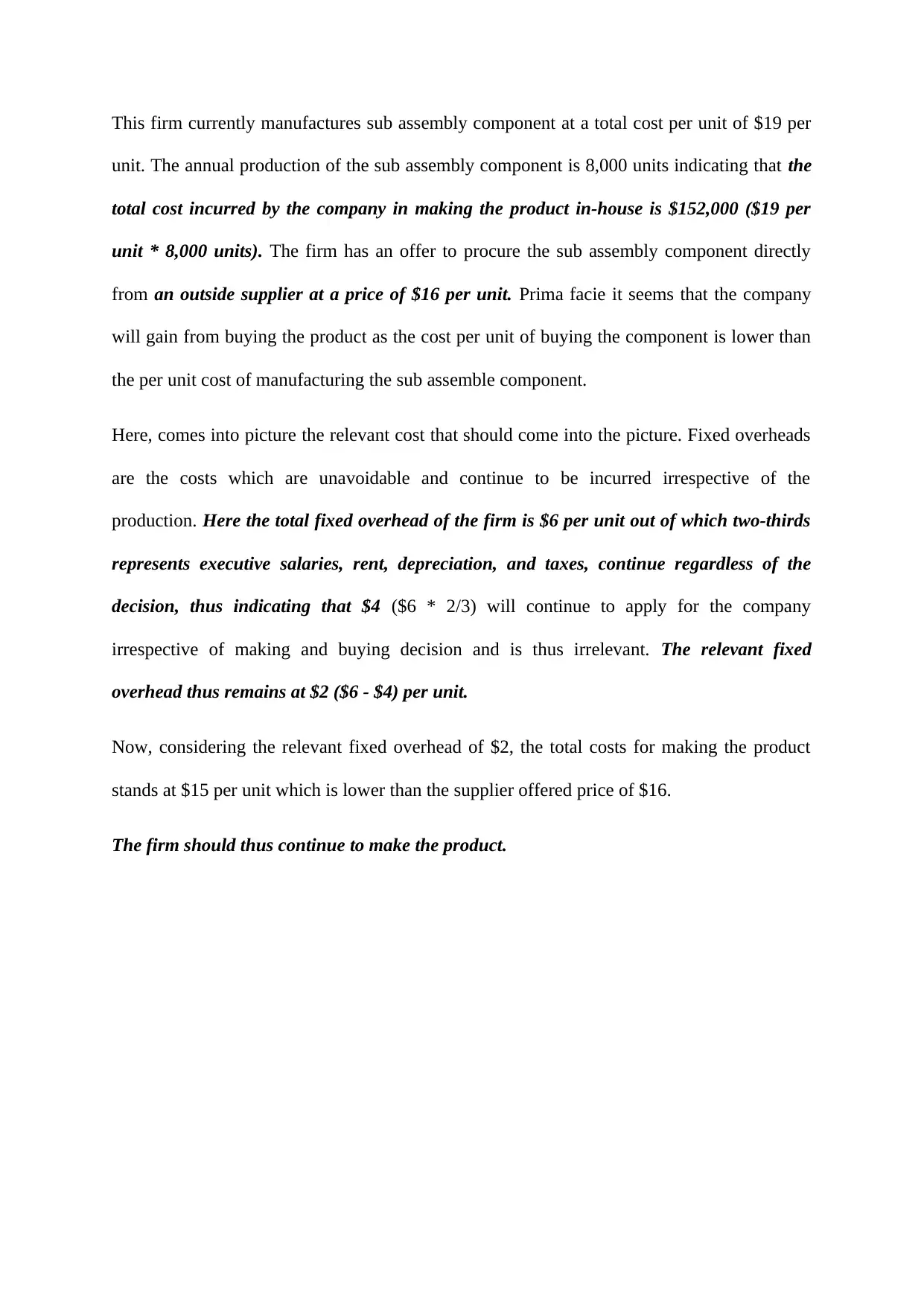
This firm currently manufactures sub assembly component at a total cost per unit of $19 per
unit. The annual production of the sub assembly component is 8,000 units indicating that the
total cost incurred by the company in making the product in-house is $152,000 ($19 per
unit * 8,000 units). The firm has an offer to procure the sub assembly component directly
from an outside supplier at a price of $16 per unit. Prima facie it seems that the company
will gain from buying the product as the cost per unit of buying the component is lower than
the per unit cost of manufacturing the sub assemble component.
Here, comes into picture the relevant cost that should come into the picture. Fixed overheads
are the costs which are unavoidable and continue to be incurred irrespective of the
production. Here the total fixed overhead of the firm is $6 per unit out of which two-thirds
represents executive salaries, rent, depreciation, and taxes, continue regardless of the
decision, thus indicating that $4 ($6 * 2/3) will continue to apply for the company
irrespective of making and buying decision and is thus irrelevant. The relevant fixed
overhead thus remains at $2 ($6 - $4) per unit.
Now, considering the relevant fixed overhead of $2, the total costs for making the product
stands at $15 per unit which is lower than the supplier offered price of $16.
The firm should thus continue to make the product.
unit. The annual production of the sub assembly component is 8,000 units indicating that the
total cost incurred by the company in making the product in-house is $152,000 ($19 per
unit * 8,000 units). The firm has an offer to procure the sub assembly component directly
from an outside supplier at a price of $16 per unit. Prima facie it seems that the company
will gain from buying the product as the cost per unit of buying the component is lower than
the per unit cost of manufacturing the sub assemble component.
Here, comes into picture the relevant cost that should come into the picture. Fixed overheads
are the costs which are unavoidable and continue to be incurred irrespective of the
production. Here the total fixed overhead of the firm is $6 per unit out of which two-thirds
represents executive salaries, rent, depreciation, and taxes, continue regardless of the
decision, thus indicating that $4 ($6 * 2/3) will continue to apply for the company
irrespective of making and buying decision and is thus irrelevant. The relevant fixed
overhead thus remains at $2 ($6 - $4) per unit.
Now, considering the relevant fixed overhead of $2, the total costs for making the product
stands at $15 per unit which is lower than the supplier offered price of $16.
The firm should thus continue to make the product.
Paraphrase This Document
Need a fresh take? Get an instant paraphrase of this document with our AI Paraphraser
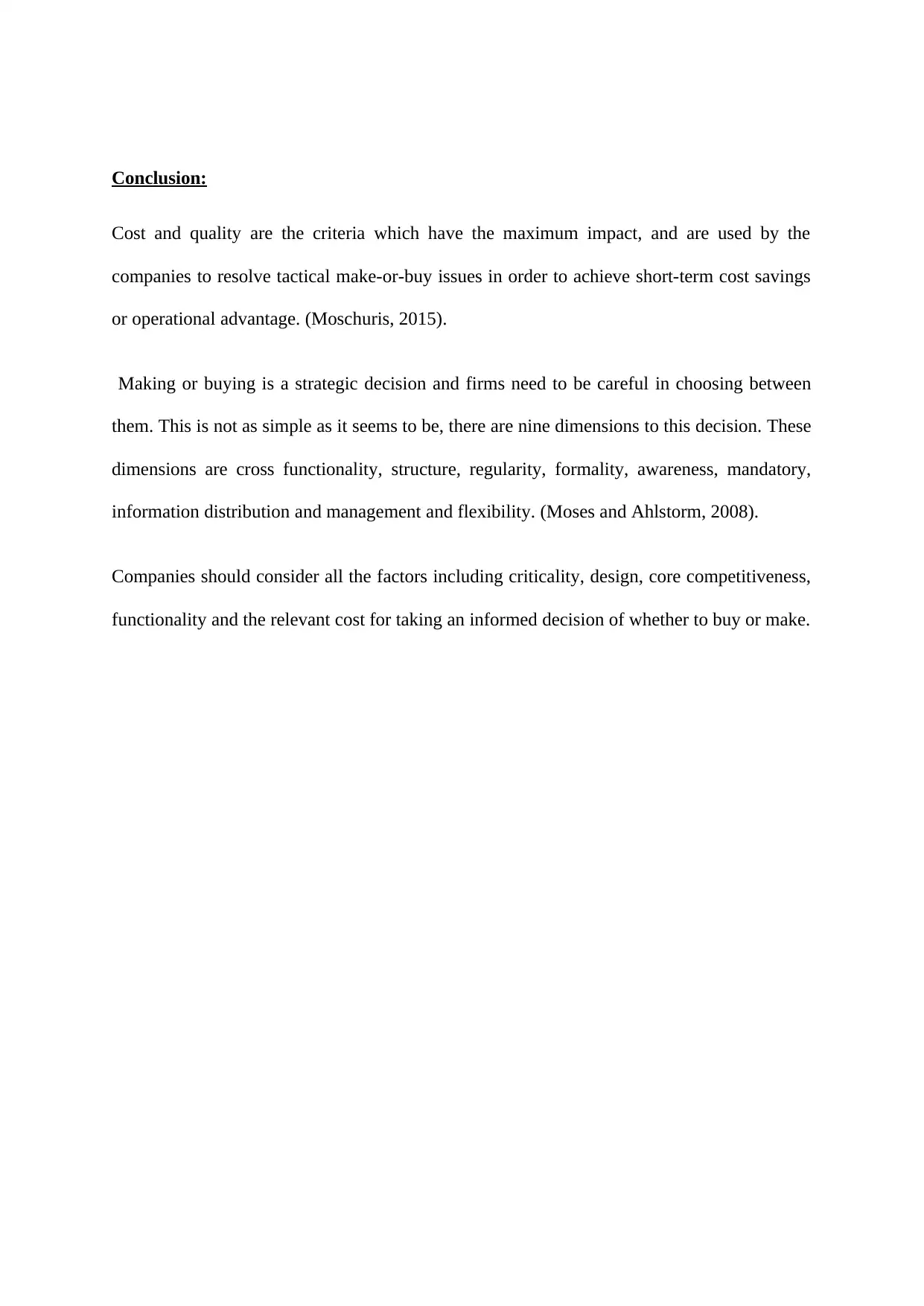
Conclusion:
Cost and quality are the criteria which have the maximum impact, and are used by the
companies to resolve tactical make-or-buy issues in order to achieve short-term cost savings
or operational advantage. (Moschuris, 2015).
Making or buying is a strategic decision and firms need to be careful in choosing between
them. This is not as simple as it seems to be, there are nine dimensions to this decision. These
dimensions are cross functionality, structure, regularity, formality, awareness, mandatory,
information distribution and management and flexibility. (Moses and Ahlstorm, 2008).
Companies should consider all the factors including criticality, design, core competitiveness,
functionality and the relevant cost for taking an informed decision of whether to buy or make.
Cost and quality are the criteria which have the maximum impact, and are used by the
companies to resolve tactical make-or-buy issues in order to achieve short-term cost savings
or operational advantage. (Moschuris, 2015).
Making or buying is a strategic decision and firms need to be careful in choosing between
them. This is not as simple as it seems to be, there are nine dimensions to this decision. These
dimensions are cross functionality, structure, regularity, formality, awareness, mandatory,
information distribution and management and flexibility. (Moses and Ahlstorm, 2008).
Companies should consider all the factors including criticality, design, core competitiveness,
functionality and the relevant cost for taking an informed decision of whether to buy or make.
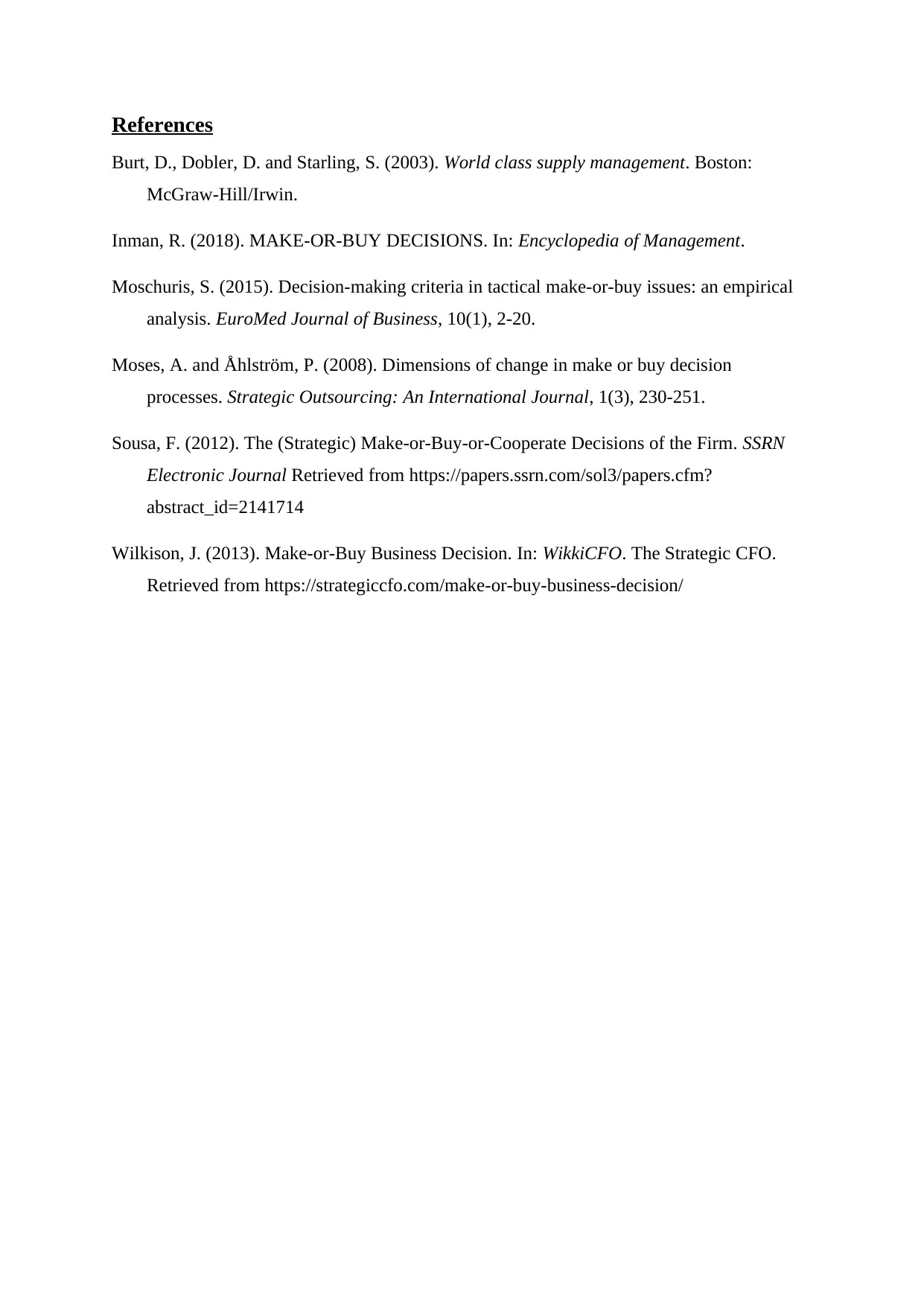
References
Burt, D., Dobler, D. and Starling, S. (2003). World class supply management. Boston:
McGraw-Hill/Irwin.
Inman, R. (2018). MAKE-OR-BUY DECISIONS. In: Encyclopedia of Management.
Moschuris, S. (2015). Decision-making criteria in tactical make-or-buy issues: an empirical
analysis. EuroMed Journal of Business, 10(1), 2-20.
Moses, A. and Åhlström, P. (2008). Dimensions of change in make or buy decision
processes. Strategic Outsourcing: An International Journal, 1(3), 230-251.
Sousa, F. (2012). The (Strategic) Make-or-Buy-or-Cooperate Decisions of the Firm. SSRN
Electronic Journal Retrieved from https://papers.ssrn.com/sol3/papers.cfm?
abstract_id=2141714
Wilkison, J. (2013). Make-or-Buy Business Decision. In: WikkiCFO. The Strategic CFO.
Retrieved from https://strategiccfo.com/make-or-buy-business-decision/
Burt, D., Dobler, D. and Starling, S. (2003). World class supply management. Boston:
McGraw-Hill/Irwin.
Inman, R. (2018). MAKE-OR-BUY DECISIONS. In: Encyclopedia of Management.
Moschuris, S. (2015). Decision-making criteria in tactical make-or-buy issues: an empirical
analysis. EuroMed Journal of Business, 10(1), 2-20.
Moses, A. and Åhlström, P. (2008). Dimensions of change in make or buy decision
processes. Strategic Outsourcing: An International Journal, 1(3), 230-251.
Sousa, F. (2012). The (Strategic) Make-or-Buy-or-Cooperate Decisions of the Firm. SSRN
Electronic Journal Retrieved from https://papers.ssrn.com/sol3/papers.cfm?
abstract_id=2141714
Wilkison, J. (2013). Make-or-Buy Business Decision. In: WikkiCFO. The Strategic CFO.
Retrieved from https://strategiccfo.com/make-or-buy-business-decision/
⊘ This is a preview!⊘
Do you want full access?
Subscribe today to unlock all pages.

Trusted by 1+ million students worldwide
1 out of 6
Related Documents
Your All-in-One AI-Powered Toolkit for Academic Success.
+13062052269
info@desklib.com
Available 24*7 on WhatsApp / Email
![[object Object]](/_next/static/media/star-bottom.7253800d.svg)
Unlock your academic potential
Copyright © 2020–2025 A2Z Services. All Rights Reserved. Developed and managed by ZUCOL.





